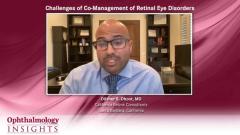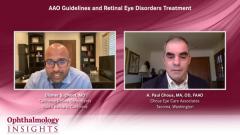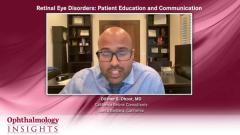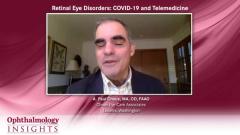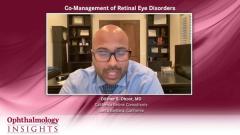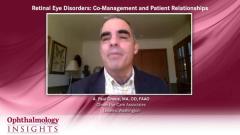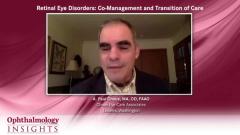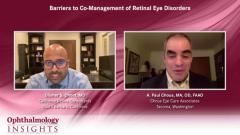
Treatment Landscape of Retinal Eye Disorders
Dilsher S. Dhoot, MD, leads a discussion about the treatment landscape of retinal eye disorders.
Episodes in this series

A. Paul Chous, MA, OD, FAAO: How would you assess the treatment landscape right now for retinal disorders? Where do you think it stands? Where do you think we’re going?
Dilsher S. Dhoot, MD: I think we’ve made a lot of progress. If you think back to 2006 when we first utilized anti-VEGF agents for wet macular degeneration, we really have come a long way. We have options for patients, where before we would simply observe as they went blind. We are in the anti-VEGF era. Anti-VEGFs are the primary treatment for several of the diseases we treat, including macular generation, diabetic macular edema [DME], retinopathy, and retinal vein occlusion. We use it off-label for other conditions as well. It’s a robust pipeline that we have in the retina space. There are multiple industry partners who are evaluating new treatments. It’s kind of a race to find more durable treatments that last longer, and that potentially dry better, to give us better efficacy results in terms of anatomy.
The bar has been set high when it comes to vision. Gaining better visual acuity results has really been difficult when you look at these head-to-head phase 3 trials. We don’t necessarily see better visual acuity gains, but we can see better durability, and we can see better drying ability with some of the newer agents that are evolving and coming onto the landscape. Where we stand now, we’re in a good position. I think that we certainly have unmet needs when it comes to the various disease states, including macular degeneration and diabetes. We see a robust pipeline, and some of that pipeline includes gene therapy, for example, which before would’ve been kind of a moonshot, but now is something that is around the corner. I really feel they will be starting phase 3 studies here on wet macular degeneration, looking at suprachoroidal and subretinal gene therapy, with very promising results also for diabetic retinopathy.
Then we also have implantable surgical devices. Recently the FDA approved an implantable surgical device, the port delivery system for anti-VEGF therapy with ranibizumab. That device also offers a greater durability for patients, especially those patients who are requiring injections every 4 or 6 weeks. It’s a great time to be practicing in the retinal field. I think it’s a great time to be a patient, and it is just getting better and better. What are your thoughts about this question, Paul?
A. Paul Chous, MA, OD, FAAO: It seems like the movement is toward extended durability of these drying agents for DME and AMD [age-related macular degeneration]. I do wonder, and I’m playing the devil’s advocate here, if longer intervals will make some patients complacent about ongoing treatment, sometimes patients get in a routine, right? “I’m seeing my retina doctor every 4 weeks or every 8 weeks.” I just wonder as we start extending out to 16 weeks and even longer, if patients will start to “blow off” the importance of going back for ongoing therapy. I have no evidence to say that might be the case, but that’s what we’ve seen in some areas. I’ll use the classically optometric example in contact lenses. When you give patients longer supplies of their contact lenses, they’re less likely to come back for their ongoing care. It becomes a bit of a dilemma in treating patients for extended durations of time. Although as a patient, I far prefer to have a medication that’s going to last 16 weeks than one that lasts 4 to 8 weeks, right?
Dilsher S. Dhoot, MD: Yes, you’re absolutely right. It’s going to be interesting to see what the adherence will be to this protocol, and even to see how retina specialists will use these drugs. If a drug is potentially labeled at 16 weeks, will we do as we’ve done before and try to extend even further? It’s sometimes a tricky game. You have to be conservative for the patient, too. I think that once you get to a certain point, it’s good to provide the patient with the pharmacokinetic support, providing a patient with a fresh supply of drugs so that their eye can be stable. Hopefully, we can educate patients that they have to come back, and I think we will.
What’s also been new is that we potentially have a new indication that will have a treatment, and that new indication is geographic atrophy [GA]. Phase 3 results were released recently of a drug that treats geographic atrophy. They were very interesting data, a little controversial. One study was positive, strongly positive, and the second study was just barely negative. The P value was very close, by a handful of patients. It’ll be very interesting to see what the FDA does with these data. We may have in our hands this coming year a treatment for geographic atrophy to slow the progression of GA. It would require frequent injections, and so it’s going to be one of those things where, again, we’ll lean on optometry to help us educate patients and try to help patients understand why these injections are necessary. That’s where imaging also comes in helpful, where you can show serial imaging and serial progression of atrophy. I think that’s another area we’re going to see, the next big thing in retina will be geographic atrophy.
A. Paul Chous, MA, OD, FAAO: Speaking of geographic atrophy, are you a fan of fundus autofluorescence for identifying geographic atrophy that is more likely to progress compared to that which is more quiescent? Is that something you think is useful?
Dilsher S. Dhoot, MD: There are some nuances to it. But at the broader level, I think fundus autofluorescence is a great gold standard in measuring GA. Looking at the changes on the borders of GA, looking for hyper autofluorescent areas, I think could be very helpful. Maybe you can further stratify which patients would most benefit from treatment. I think in general, yes, fundus autofluorescence is a great tool.
A. Paul Chous, MA, OD, FAAO: I’m curious because my colleagues in optometry are going to say, “Why didn’t you ask Dr Dhoot this question?” What do you think about the potentiality of topical agents for treating DME orneovascular AMD? And what about photobiomodulation? I look at these studies all the time, some are impressive.,They’re mostly phase 1, phase 2 studies, with small numbers of patients, but do you think either of those treatment modalities hold any promise for the future?
Dilsher S. Dhoot, MD: Up until now, we’ve had a very difficult time getting enough drug into the eye through a topical route. We’ve seen that the intravitreal delivery has really been necessary. There are studies looking at oral medications, which are actually promising. We might have an oral medication before we have a topical medication, I think. As far as biomodulation, it’s so early to know. It’s not something that in the mainstream retinal field we talk a lot about because the results are still, I think, a way out there. I don’t think we’re going to see that anytime soon.
TRANSCRIPT EDITED FOR CLARITY
Newsletter
Don’t miss out—get Ophthalmology Times updates on the latest clinical advancements and expert interviews, straight to your inbox.


